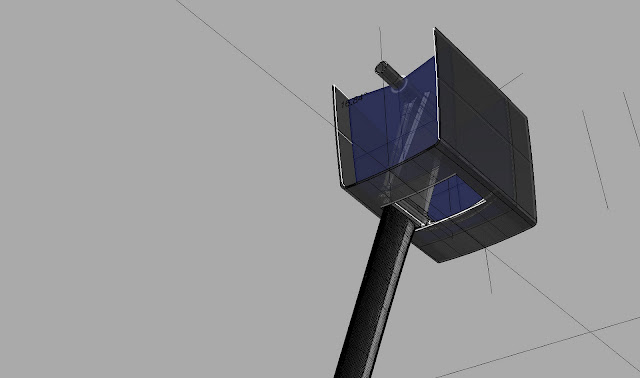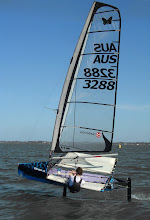Its been about 10 months since the worlds. A pretty good amount of time to rest, digest new information, work on other things etc etc. But, the itch to go sailing is back and I now have a Doink-built Alpha shell (thanks mate!) sitting in the garage waiting to get turned into a new boat.
So, the plan was to start with the most outrageous contraption possible, and gradually change it into something that sort of worked. I'm not sure about that plan anymore, due to day to day time constraints and the pressures of modern life and whatever else. So, I've decided to go with something more conventional. Evolutionary rather than revolutionary, and maybe then try and put a wing on it.
But, it seems like a waste to just chuck ideas away, so I decided to post some things I've been thinking about on here, maybe generate a bit of discussion and possibly inspire someone else to take it a step or two further. They might trickle in, but here's the first one.
The canting foil.
After an initial thought experiment and then some basic 2d cad "calculations," I decided that this would probably be worth a try. But a discussing it with Nick and Markla, we came to the conclusion that it was going to be a lot of work and structural compromise for no a huge gain. Markla did a few proper numbers to illustrate this point. Anyway, I'm still not completely discouraged and it will just go on the back burner I think!
The system I arrived at to make this work is as follows: The foil cants side to side about a bearing mounted at deck level. Very important to have the bearing on the deck, as you seem to get absolutely no advantage over a fixed foil with it at the keel. The bearing needs to be pretty snug, so there are replaceable nylon inserts inside the carbon tube. The centreboard case is supported from the top, but a sliding 'car' that runs along a bit of aluminium bike rim acts as a third point in case you hit a sand bank. I was initially thinking of using a stainless lead screw to control the cant, but decided there was too much machining involved, so I went for an 8:1 purchase system running through laminated-in thimbles. The purchase would need a serious amount of pre-tension in the form of a big bungee to compensate for the changes in line length between 'centred' and 'canted'. Even so, you would never achieve the stiffness from the foil that you get from a fixed centreboard case. That's probably the biggest trade-off. Another issue is that you're left with a large hole in the bottom of the boat, which is among other things a structural problem. This is overcome by some longditudinal bulkheads that tie the fore and aft bearings into the chines and act as beams to stop the hull from snapping. A laterally sliding carbon plate, flexible in one direction only, sits around the base of the foil and fits into a specially moulded carbon groove at the front and back of the hole (not modeled, quite difficult to draw actually) and a small fixed venturi drains it.
In the end, the foil can cant through about 15 degrees comfortably, which is all you would need. From a sailing point of view, i envisaged that the controls would be quite lightly loaded and accurately adjustable. You would probably just centre it in the tacks and when sailing downwind. its an upwind device really.
So, the plan was to start with the most outrageous contraption possible, and gradually change it into something that sort of worked. I'm not sure about that plan anymore, due to day to day time constraints and the pressures of modern life and whatever else. So, I've decided to go with something more conventional. Evolutionary rather than revolutionary, and maybe then try and put a wing on it.
But, it seems like a waste to just chuck ideas away, so I decided to post some things I've been thinking about on here, maybe generate a bit of discussion and possibly inspire someone else to take it a step or two further. They might trickle in, but here's the first one.
The canting foil.
After an initial thought experiment and then some basic 2d cad "calculations," I decided that this would probably be worth a try. But a discussing it with Nick and Markla, we came to the conclusion that it was going to be a lot of work and structural compromise for no a huge gain. Markla did a few proper numbers to illustrate this point. Anyway, I'm still not completely discouraged and it will just go on the back burner I think!
The system I arrived at to make this work is as follows: The foil cants side to side about a bearing mounted at deck level. Very important to have the bearing on the deck, as you seem to get absolutely no advantage over a fixed foil with it at the keel. The bearing needs to be pretty snug, so there are replaceable nylon inserts inside the carbon tube. The centreboard case is supported from the top, but a sliding 'car' that runs along a bit of aluminium bike rim acts as a third point in case you hit a sand bank. I was initially thinking of using a stainless lead screw to control the cant, but decided there was too much machining involved, so I went for an 8:1 purchase system running through laminated-in thimbles. The purchase would need a serious amount of pre-tension in the form of a big bungee to compensate for the changes in line length between 'centred' and 'canted'. Even so, you would never achieve the stiffness from the foil that you get from a fixed centreboard case. That's probably the biggest trade-off. Another issue is that you're left with a large hole in the bottom of the boat, which is among other things a structural problem. This is overcome by some longditudinal bulkheads that tie the fore and aft bearings into the chines and act as beams to stop the hull from snapping. A laterally sliding carbon plate, flexible in one direction only, sits around the base of the foil and fits into a specially moulded carbon groove at the front and back of the hole (not modeled, quite difficult to draw actually) and a small fixed venturi drains it.
In the end, the foil can cant through about 15 degrees comfortably, which is all you would need. From a sailing point of view, i envisaged that the controls would be quite lightly loaded and accurately adjustable. You would probably just centre it in the tacks and when sailing downwind. its an upwind device really.








13 comments:
right idea; wrong axis! =:-)
Karl, this turns around x and y, but i presume you mean z? interesting..! are you working on something?
i think karl is on the right track, but why pivot at the deck when you can pivot at the foil tip...
nice model nick.
Right idea and right axis ! But it might have some downwind potential as well.
Good to have you back Nick. Is this a new Doinka shell or one of the two old ones that is getting a rebuild?
The canting foil has been done already on a boat over here in WA, although it hasn't seen a great deal of testing. Instead of pivoting at the deck though, it pivots about the keel in a V shaped case. It's rumoured to be not slow, but it hasn't lined up against more 'normal' boats. We're expecting it to show up at our states in February though... i'll take some pics for you if you want.
Oops - above comment by Jon Emonson
Dave, thanks that's encouraging! I guess that just illustrates how many potential avenues for development there are.
Jon, hey mate! Yeah, doink made me a new pre-preg shell from the Gilmour mould. Awesome to hear that someone's already on this, photos would be great . I'll watch the results closely. If it shows potential, then it might be worth the experiment after all. The big question in my mind is what is the optimum angle for the foil to be under the water. Currently we sail upwind with a 15 - 20 degree heel, but would it be better to have the foil at say 30 degrees? A keel-stepped system would be a pretty good way to figure that out.
I had two other thoughts (probably wrong):
1. If spray drag on the strut goes up with Cl, perhaps you wouldn't want it generating a whole lot of lift? Then again, it is down there so why not have it do something.
2. Isn't the 20 degree canted rig lifting significantly, decreasing the load on the foils and thereby the foil drag upwind? By de-canting the rig you lose some of this benefit, no?
3. No I am not gybing the board only doing the active AOA which I guess is Y if fore and aft is X.
Hey Karl, yeah I'm planning on doing at least adjustable angle of attack. Ill email you about the active thing.
I realised that my strut foil section is total crap (drag bucket) outside about 2.5 degrees aoa, so it might be nice to ensure that it is pretty much always unloaded. Jibing it would help, but first I want to get some idea if the leeway we make. Upwind it can be serious I suspect.
Re: having the rig contribute to foil lift, you could be quite right. I'm not sure about it either way. I might try and do some maths on the loads like markla did the other day, because that's an important question.
I think the wave and spray drag can be large over and above the form/drag bucket considerations. IIRC Bill mentioned that it worked out to more than predicted in his tests. Trifoilers have lots of side load on the vertical though and they go pretty fast, so maybe not significant. Ventilation becomes an issue but maybe not for the sideloads generated by a Moth.
I was thinking about that - I've definitely spun out from the centerboard venting, sailing downwind with the boat high and flat. Also sailing high upwind (could be the foil tip breaking the surface?). The ventilation would only occur with a pretty high pressure peak so i'd guess it sees some significant side load sometimes.
Nick, could be potential here, but it needs to be simple... You get some similar advantages to the canting rig (still a work in progrees and may get looked at next month if I get back to Aus). I agree with Dave, there is potential downwind also.
Regarding Strut loading, I've whiped out off the main strut before. It takes some load some time, but my theory is that we want to reduce the load it takes as much as we can. Just a quick two cents,
Alan
Good Stuff
Post a Comment